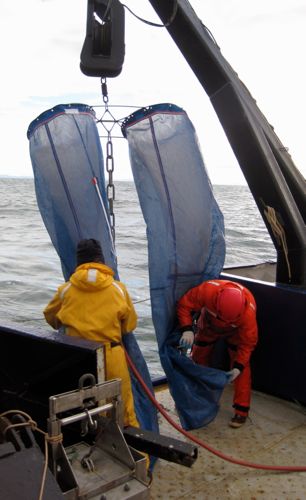Once again, with everyone suited up and ready to go at 4:30 AM, we had to cancel our work at the biology station. The CTDA research tool that is submerged in the water to measure conductivity (salinity), temperature, and depth. went in successfully over the stern, but it was obvious when the the zooplankton nets were launched over the side, that the roll of the ship, coupled with the dark nighttime conditions, was too much for any additional work. So – back to sleep!
The zooplankton team on board, Dr. Russ Hopcroft, UAF, and Dr. Ksenia Kosobokova, from the Shirshov Institute of Oceanology, Russian Academy of Sciences, Moscow, and graduate students Elizaveta Ershova and Imme Rutzen work in the lab adjacent to ours. Russ and Ksenia are interested in zooplankton, animals that drift in the water. Although many think of zooplankton as small, even microscopic, they can be as large as a jellyfish and may be passive drifters or slow swimmers. In order to sample all zooplankton, Russ and Ksenia use three different nets, a paired, vertically deployed net which captures the smallest zooplankton, a bongo net which is trawled for up to ten minutes for the larger ones, and a smaller single net which is deployed off the back by hand. They're always busy; they not only sample at nearly all stations, they work for hours in the lab every day. After they have collected their samples, Russ and Ksenia will look through them to identify and enumerate rare species, and then preserve them, either in ethanol (for later genetic analysis) or in formalin for determination of community composition. Review of the samples from the hand deployed net allows them to describe, non-quantitatively, what´s at each station, and photograph the species present. From unpreserved collections they´ll select female copepods (tiny crustaceans that are an important food source for many animals) for experimental work. Finding adult females of the one genus they are studying in numbers sufficient for their work can take anywhere from one to four hours as they search through thousands of zooplankton. This can be tricky if these females are rare or overwhelmed by sub-adults of the target genus. Once they´ve found enough adult females, they fill small bottles with water from the CTDA research tool that is submerged in the water to measure conductivity (salinity), temperature, and depth. and, after placing one female/bottle, they´ll move the bottles into an incubator set for the temperature of seawater. After 24 and 48 hours, Russ and Ksenia remove those copepods that have laid eggs and preserve them. All those that have laid eggs are individually preserved and will later be examined to determine species and number of eggs laid from the total population incubated. The particular genus with which they are working is the most important and prominent one on the ocean shelf, and Russ and Ksenia are interested in overall reproduction rates. Following this cruise, they'll have data from each of the three RUSALCA cruises – '04, '09 and now 2012. Unfortunately the weather has not cooperated so far, and it's been tough to get all the samples they need.



Comments